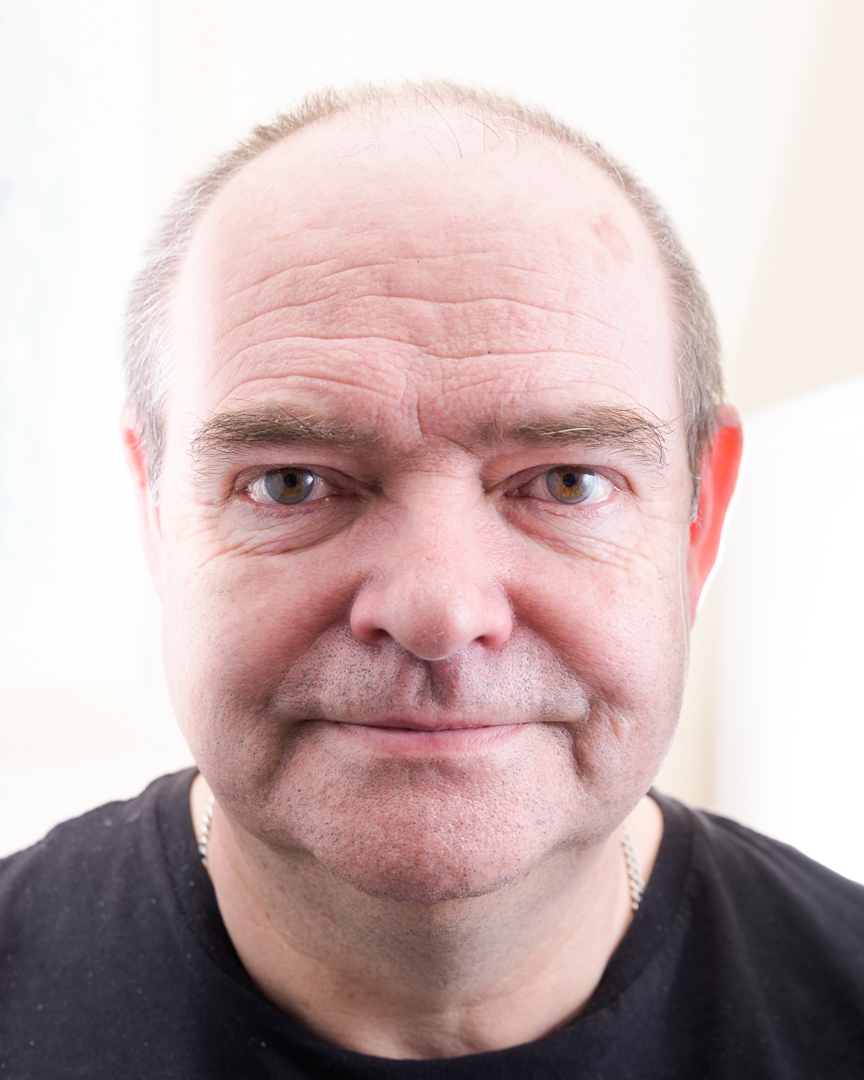Concept: Does the wearing of a mask impact on the viewers perception of who someone is and does the environment change that perception?
Due to lockdown regulations, it has been difficult to photograph people, especially indoors. So this Assignment has focused on one sitter; exploring the wearing of face masks (a COVID pandemic requirement) and whether or not it hinders the viewers ability to get a sense of the sitter’s identity and coupled with that, how does the setting / mood of the image change the viewer’s perception of the person.
Richard Pearce· Most portrait shots show a person’s face, and especially the eyes – it’s what we expect of such a shot – but the sense of a person can be conveyed without the face being seen at all, relying instead on elements such as colour, angle, props, activity etc to ‘tell a story’ about that person.
The subject is same in each image, he was sat in the same position on a chair, using the same flash lighting for each image. Using photographic backdrops, the backgrounds were changed behind him. The lighting is deliberately flat, so as to not influence the viewer with dramatic lighting. In the final image, he is left unmasked, does this change the perception of his identify and feelings?
Martin Schoeller’s Close up series, https://martinschoeller.com/SERIES/Close-Up/1 inspired this look, although the images have not been cropped in so tightly, as the background was in empirical part of this exercise.
In Pogosyan and Englemann’s article, Pogosyan M and Engelmann J (2017) How We Read Emotions from Faces. Front. Young Minds. 5:11. doi: 10.3389/frym.2017.00011 – “. . . people pay attention to different parts of the face when trying to figure out what others are feeling. East Asian participants, for example, mostly look for clues from the eyes. Western participants find their clues more from the whole face, including the eyes, the eyebrows, the nose, and the mouth. This suggests that people from different cultures express their emotions using different facial signals, and also, different cultures analyze facial gestures differently ” . . . .
Bearing this in mind, in a Western society, does the wearing of a face masks reduce our ability to figure out what the sitter is feeling? The subject was asked to show certain emotions on his face, however, these will be him pulling faces and not really emotions so may be more difficult to read.
Conclusion:
As a photographer it is more difficult to create a sense of someone’s identity whilst they are are wearing a face mask. Being mindful of the setting in which you place the sitter could add some feeling or ambience to the image, however, in this close up style with flat lighting it still doesn’t add much to the story of the sitter.
Reflection
Whilst I think this set of images answers the brief and answers the questions posed, it’s not an aesthetically pleasing set of images. In these images the mask is the subject rather than the person. I often feel claustrophobic in small places and find wearing a mask myself uncomfortable. I think that comes across in the images, but that might be more about how I feel about them than other viewers. Maybe reconsidering Richard Pearce’s remarks above might help?
I’m not sure the final ‘unmasked’ image works in the set, and may consider another masked image to include. The set does demonstrate the importance of the setting and I have considered how a set depicting the same sitter but in wider settings, doing things or outside might improve the sense of identity, even though you can’t see all of his face.
Bibliography
Nicholls-Lee, Deborah. “How Masks Have Appeared in Art.” Www.bbc.com, 12 May 2020, www.bbc.com/culture/article/20200512-how-masks-have-appeared-in-art. Accessed 11 Nov. 2020.
Pearce, Richard. “40 Portraits without Faces Ideas | Faceless Portrait, Portrait Shots, Portrait.” Pinterest, www.pinterest.co.uk/richp01/portraits-without-faces/. Accessed 11 Nov. 2020. search for faces in portraits.
Pogosyan, Marianna, and Jan Benjamin Engelmann. “How We Read Emotions from Faces.” Frontiers for Young Minds, vol. 5, 24 Apr. 2017, 10.3389/frym.2017.00011.
Teno, Karyn. “9 Ways to Evoke Emotion & Feeling in Your IPhone Photos.” IPhone Photography School, 15 May 2015, iphonephotographyschool.com/emotion/.
“The Art of Using Backgrounds to Create Moody Photos.” Photo & Video Envato Tuts+, photography.tutsplus.com/articles/the-art-of-using-backgrounds-to-create-moody-photos–photo-4699. Accessed 11 Nov. 2020.
“The Seven Universal Emotions We Wear on Our Face – the Nature of Things: Science, Wildlife and Technology.” Www.cbc.ca, www.cbc.ca, 2019, www.cbc.ca/natureofthings/features/the-seven-universal-emotions-we-wear-on-our-face.
Wegrzyn, Martin, et al. “Mapping the Emotional Face. How Individual Face Parts Contribute to Successful Emotion Recognition.” PLOS ONE, vol. 12, no. 5, 11 May 2017, p. e0177239, 10.1371/journal.pone.0177239.
“What Is the Correct Way to Use ‘Vice Versa’?” Www.dictionary.com, 2018, www.dictionary.com/browse/vice-versa. Accessed 19 Nov. 2019.







1 thought on “Assignment 2 – Vice Versa”
Comments are closed.